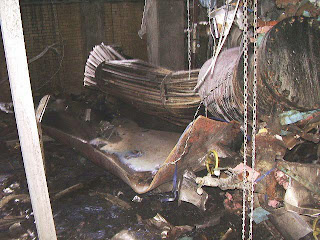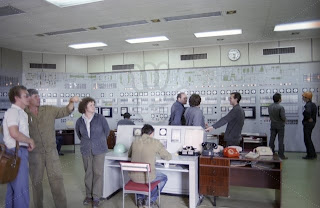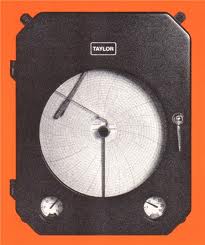Thanks to Mr Harbhajan Singh Seghal for sending this incident:
INCIDENT
In one of the chlorine consuming industry two persons were affected with chlorine while the operator disconnected the tonner from the process due to hard valve operation of the tonner.
DETAILS OF INCIDENT
· The consumer withdraws liquid chlorine from the chlorine tonner and consumes gas after evaporation.
· As per practice, the consumer keeps the tonner in line to withdraw maximum chlorine from the tonner.
· On the specific day of the incident, the operator tried to isolate the tonner at 1.0kg/cm2 pressure when about 40-50 kgs liquid chlorine was left in the tonner and there was ice formation at the bottom of the tonner.
· He could not close the valve fully. The spindle of the valve damaged due to excessive force.
· The operator decided to cut off the tonner by wearing SCBA.
· This action resulted in heavy gas leakage and affected two persons in the surrounding area.
ACTION TAKEN
· The tonner brought to the works.(of the chlorine supplier)
· It was depressurized and the valve was dismantled
· Iron chloride rust and greenish color sludge was observed in the threading of the valve.
· Damaged valve replaced with new valve.
ROOT CAUSE
· Liquid chlorine withdrawal rate is 180 kgs/hr. Maximum liquid chlorine is used up in 4-5 hrs operation at this rate. Some quantity (40-50) kgs remains in the tonner at the bottom.
· Some consumers try to recover this 40-50 kg liquid chlorine as gas by keeping the tonner in line for more time.
· The left over liquid chlorine evaporates at 5-6 kgs/hr as gas and lowers the temperature of the tonner/pipe lines due to fall in pressure till the remaining liquid chlorine is exhausted.
· 1.0 kg/cm2 pressure can lead to about -20 degree C and takes 8-10 hrs to completely empty the tonner.
· Normally chlorine in the tonner is dry. But under such conditions (-200) the same chlorine becomes wet.
· Water in the chlorine separates out and freezes in the spindle of the chlorine valve. It makes the valve hard to operate at that time.
· After attaining normal temperature, chlorine evaporates first and water later. This chlorinated water reacts with the sprindle and makes the chlorine spindle greenish.
· The evaporators which do not have backflow prevention system (from evaporator to chlorine tonner) results carry over of iron chloride rust to valve spindle and makes the valve hard in operation.
LESSONS LEARNT
· The tonners containing some quantity of liquid chlorine (40-50 Kg) are not to be cut off at 1.0kg/cm2. The tonner is to be depressurized by releasing the chlorine to neutralization system through header or evaporator.
· After depressurizing, check that no chlorine gas comes from the upper valve of the tonner, and also check that no ice formation appears on tonner or pipe lines before the tonner is disconnected.
· Chlorine header and evaporator must have chlorine release facility connected to neutralization system.
· Chlorine evaporator must have liquid chlorine flow control interlocked with temperature and outlet pressure to avoid the back flow of chlorine
· Evaporator should have emergency release system with rupture disc and safety valve.
· Temperature of evaporator should be maintained between 80-85 degree C to avoid formation of rust as Fecl3 in the evaporator.
· Dry air (-40 degree) dew point is to be utilized for evaporator maintenance.
· Glass wool filter is to be utilized in gas line to avoid carry over of Fecl3 to main products and choking in chlorine system.
· Tonners can be kept in tilted position forming 20-30 degree angle to withdraw maximum liquid chlorine from the tonner.
MOST IMPORTANT LESSONS
· No chance should be taken with liquid chlorine system. Help of the filler (chlorine supplier) must be taken in such cases. One volume of liquid chlorine expands to 460 times
· Chlorine neutralization system must be effective and checked from time to time.
· Single person should never take this type of emergency job.
· Always stand by person ready with safety equipments should be present during such operations.
INCIDENT
In one of the chlorine consuming industry two persons were affected with chlorine while the operator disconnected the tonner from the process due to hard valve operation of the tonner.
DETAILS OF INCIDENT
· The consumer withdraws liquid chlorine from the chlorine tonner and consumes gas after evaporation.
· As per practice, the consumer keeps the tonner in line to withdraw maximum chlorine from the tonner.
· On the specific day of the incident, the operator tried to isolate the tonner at 1.0kg/cm2 pressure when about 40-50 kgs liquid chlorine was left in the tonner and there was ice formation at the bottom of the tonner.
· He could not close the valve fully. The spindle of the valve damaged due to excessive force.
· The operator decided to cut off the tonner by wearing SCBA.
· This action resulted in heavy gas leakage and affected two persons in the surrounding area.
ACTION TAKEN
· The tonner brought to the works.(of the chlorine supplier)
· It was depressurized and the valve was dismantled
· Iron chloride rust and greenish color sludge was observed in the threading of the valve.
· Damaged valve replaced with new valve.
ROOT CAUSE
· Liquid chlorine withdrawal rate is 180 kgs/hr. Maximum liquid chlorine is used up in 4-5 hrs operation at this rate. Some quantity (40-50) kgs remains in the tonner at the bottom.
· Some consumers try to recover this 40-50 kg liquid chlorine as gas by keeping the tonner in line for more time.
· The left over liquid chlorine evaporates at 5-6 kgs/hr as gas and lowers the temperature of the tonner/pipe lines due to fall in pressure till the remaining liquid chlorine is exhausted.
· 1.0 kg/cm2 pressure can lead to about -20 degree C and takes 8-10 hrs to completely empty the tonner.
· Normally chlorine in the tonner is dry. But under such conditions (-200) the same chlorine becomes wet.
· Water in the chlorine separates out and freezes in the spindle of the chlorine valve. It makes the valve hard to operate at that time.
· After attaining normal temperature, chlorine evaporates first and water later. This chlorinated water reacts with the sprindle and makes the chlorine spindle greenish.
· The evaporators which do not have backflow prevention system (from evaporator to chlorine tonner) results carry over of iron chloride rust to valve spindle and makes the valve hard in operation.
LESSONS LEARNT
· The tonners containing some quantity of liquid chlorine (40-50 Kg) are not to be cut off at 1.0kg/cm2. The tonner is to be depressurized by releasing the chlorine to neutralization system through header or evaporator.
· After depressurizing, check that no chlorine gas comes from the upper valve of the tonner, and also check that no ice formation appears on tonner or pipe lines before the tonner is disconnected.
· Chlorine header and evaporator must have chlorine release facility connected to neutralization system.
· Chlorine evaporator must have liquid chlorine flow control interlocked with temperature and outlet pressure to avoid the back flow of chlorine
· Evaporator should have emergency release system with rupture disc and safety valve.
· Temperature of evaporator should be maintained between 80-85 degree C to avoid formation of rust as Fecl3 in the evaporator.
· Dry air (-40 degree) dew point is to be utilized for evaporator maintenance.
· Glass wool filter is to be utilized in gas line to avoid carry over of Fecl3 to main products and choking in chlorine system.
· Tonners can be kept in tilted position forming 20-30 degree angle to withdraw maximum liquid chlorine from the tonner.
MOST IMPORTANT LESSONS
· No chance should be taken with liquid chlorine system. Help of the filler (chlorine supplier) must be taken in such cases. One volume of liquid chlorine expands to 460 times
· Chlorine neutralization system must be effective and checked from time to time.
· Single person should never take this type of emergency job.
· Always stand by person ready with safety equipments should be present during such operations.



